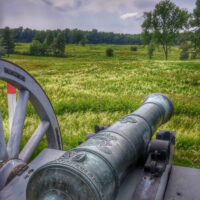The Acton Historical Society (AHS) hosted its monthly Open House at the Hosmer House Museum on Saturday afternoon, October 21, and visitors had a chance to view the new exhibit, “Acton’s Schools, Then and Now.” Also on display was a poster project by two 2023 Acton Boxborough Regional High School (ABRHS) graduates, Emi Fung and Isha Agarwal, on immigration, discrimination, and changing racial demographics at ABRHS.

The schools exhibit, set up in a room at the front of the house, featured informational panels with numerous photos from the AHS collection, maps, school desks, and a slate from an Acton school. One interesting narrative outlined the “high school question” that gave rise to “legendary fighting” in the Town. In 1907, there was no high school in Acton, and the state’s intervention resulted in students in grades 10-12 being sent to Concord High School. Ella Miller reported on a 1914 Town Meeting vote of whether to build a high school in Acton, with 160 “yes” and 162 “no” votes, noting that Reverend Wood and Frank Knowlton were the “chief speakers against.” After another decade of grappling with the question of whether and where to build a secondary school, in 1925, the Acton High School program began.
Population growth saw Acton facing crowded classrooms in all of its schools by 1949. A room for a first grade class had to be rented at the Center Congregational church. A search for additional classroom space began. By 1951, Acton was sending two classes of second graders to Maynard schools, and another first grade class was meeting upstairs at the Center Fire Station. Exploring the exhibit, AHS member Dick O’Neil recalled that his sister Mary, now living in Florida, attended school at the fire station. Another member, Bill Klauer, recalled attending second grade at the Coolidge school in Maynard until a fire forced students to return to West Acton to attend class in the Jenks Apartments.
Many of the schoolhouses shown in exhibit photos have long ago been torn down, but a few remain. A c. 1797 schoolhouse at 86 School Street in South Acton still stands, and is a residence. The late 1840s schoolhouse located at 239 Arlington Street was remodeled and moved to 33-35 Spruce Street, another residence. The 1839 school located at 68 Harris Street in North Acton, although a dwelling for over 100 years, was recently torn down to build the North Acton Fire Station that opened last spring. The village schools all closed between 1957 and 1959, and the growing student population was educated at the schools on the “Educational Campus” on Charter Road and, later, the “Minot Avenue School” that became Conant, as well as Gates and Douglas elementary schools (now demolished and rebuilt at the new Boardwalk Campus) in West Acton.
One info panel provided biographies of several key figures, teachers, principals and a school physician, in the history of our schools, for whom many are named: Paul P. Gates, Luther Conant, Florence Merriam, Marion L. Towne, Julia McCarthy, and Raymond J. Grey.
Another museum visitor, Alex Chayrigues, a high school student at Concord Carlisle Regional High School, stopped by the Hosmer House to interview AHS members about Acton residents who fought in the Battle at the Old North Bridge in Concord on April 19, 1775. Chayrigues is a member of a youth leadership team of the American Battlefield Trust, a national organization working to promote battlefield preservation. He is profiling some of the soldiers who fought that day in Concord. “I’m doing a passion project,” says Chayrigues. The project will culminate in an exhibit at the Concord Free Public Library or the Concord Museum next spring.
Set up in the kitchen were several posters featuring quotes from oral histories compiled by Acton Boxborough students Fung and Agarwal this past summer. The pair interviewed ABRHS students, collected demographic information from district enrollment records, and located class photos depicting the changing face of the high school population over time, from the graduating class of 1988 to the class of 2023. One student visitor noted, “I think at least in my experience, discrimination manifested in a culture of ‘South Asian people are irrelevant to our community at best.’ And they occupy a very specific [space].” Another student recalled, “[At ABRHS] I think there was a lot of that social segregation. And it was very stratified based on race lines.” Another student opined, “It’s not necessarily actions of other people, but more of the apathy. Like I think it’s like [the feeling of] no one’s gonna look at you and see you really… lf they feel uncomfortable by your presence, they’ll ignore you.” Another student offered, “Looking back, it would have been nicer to be much more integrated with the rest of Acton and everything else. But…that’s how it was because of the social structure and the cultural structures.” Yet another student expressed, “Today, there’s a lot that goes on in Acton…and it comes from every immigrant culture. For us being immigrants, it’s fabulous to see it grow this way.”
More information about the Historical Society is available at Acton Historical Society.

